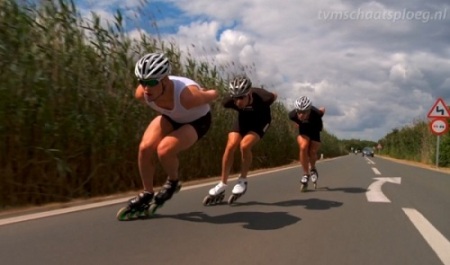- Can Skaters Train on Both Inline and Ice?
- Cross-training on Ice
- About.com: Inline Speed Skaters Switch to Ice for Olympics
- Ça roule pour Valérie Maltais
- Team USA: Watch Dem Speedskaters Whip … From Wheels To Ice
SKATERS WHO HAVE COMPETED ICE AND INLINE (ROLLER)
Long Track: Bart Swings, Erin Jackson, Brittany Bowe, Derek Parra, Jordan Belchos, Cindy Klassen, Mahthieu Giroux, Heather Richardson, Livion Wenger, Patrick Meek, Alexis Contin, Ronald Mulder, Peter Michael, Francesca Lollobrigida, KC Boutiette, Joey Mantia, Kimi Goetz
Short Track: Chris Crevling, Olivier Jean, Jessica Smith-Kooreman, Kimi Goetz and Keith Carroll Jr., Jordan Malone, Apolo Ohno, Mathieu Turcotte, Valerie Maltais, Marianne St-Gelais, Travis Jayner
The great Dutch skater, Olympic Champion and World Record holder, Sven Kramer uses inline & roller for training
Historically, athletes have managed to move swiftly and successfully, back and forth, between racing on ice blades and racing on wheels. Many athletes, clubs and teams are able to effectively manage short track, long track and roller & inline speed skating seasons and performances.
Some of skaters who have managed to jump between ice and inline racing include Chad Hedrick- USA (Olympic Gold in long track, most medals won at World Roller Speed Skating Championships), Olivier Jean- Canada (Olympic Gold in short track, Canadian Marathon Champion in inline), and Bart Swings- Belgium (World Champion in inline, World Single Distance Championships in long track).
WIN-WIN WHEN CLUBS HAVE ICE & INLINE
A shining example of a healthy working relationship between ice and roller speed skating clubs is that of the Toronto Speed Skating Club and the Toronto Inline Skating Club. Numerous members of each Club take part in each other’s practices, competitions and social outings.
When ice and inline clubs manage to form a reciprocal membership, each club stands to gain in many ways. This includes a deeper volunteer base as well as a larger pool of athletes and members to help increase a variety of ability groups. Because of the offsetting seasons, ice skaters can use inline skating as a way to help with off-season training, and vice-versa.
IT’S ABOUT TECHNIQUE
Ice skating and inline skating are similar sports in many ways. Technically, the same foundation principles apply when it comes to technique. Knee and ankle bend and maintaining a low position is important on ice and on wheels.
Starts and accelerations can be reinforced on wheels for ice and on ice for wheels.
When used properly, ice and inline skating can be used to reinforce each others’ proper skating by way of introducing new technical concepts and drills as well as revisiting well-known activities and movements.
One way inline and ice will vary is in stride rate. Inline skaters tend to have higher stride rate because of the increased friction between the wheels (polyurethane) and skating surface (asphalt, concrete, wood).
MANAGING SEASONS & TRAINING CYCLES
When a skater or a club adopts ice or inline as an off-season training choice, there are challenges that coaches, athletes and parents have to be aware of and understand. This includes managing the seasonal and training cycles. Coaches need a good understanding of sound training principles so athletes can perform well and be in optimal shape for certain times during the season.
PROTECTIVE EQUIPMENT
Ice and inline skating differ in terms of basic required protective equipment. On ice, skaters need Kevlar suits, shin guards, cut-proof gloves, a helmet and neck guards. None of the skin can be exposed and glasses must be tint-free. For inline skating, skaters usually only require a helmet. It is highly recommended that skaters wear palm protection (cycling gloves). Less-agile as well as younger skaters are encouraged to wear knee and elbow protection as well as mouth guards. Finally, inline skaters can also wear Kevlar leg and arm clothing that prevent skin burns when falling.
DIFFERENT STYLES & DISTANCES
Racing styles and distances are quite different when it comes to ice and inline. Short track skaters normally skate shorter distances on fairly standard tracks. Inline skaters, on the other hand, compete on roads with climbs and hills or at times on tracks that range from 100-meter indoor tracks (wood or cement), 200-meter banked track (inclined corners), and 400-meter flat tracks, as well as on race-courses with right and left turns, and on asphalt that can vary in grade and quality.


Hi I am getting my speed skaters to pursue inline training this summer in Calgary. I was wondering where I can get frame and wheel sets to put on their short track boots – love that you are offering partnership opportunities= wish I coached on Toronto!
Hi
I’m speed skater I’m wondering to know where can I practice in Montreal?is there any rink for roller speed skating?
tnQ
Hello Masha- try contacting VRL le Club- they use the Olympic Stadium, skating there at least once per week. https://www.facebook.com/groups/11317484025/